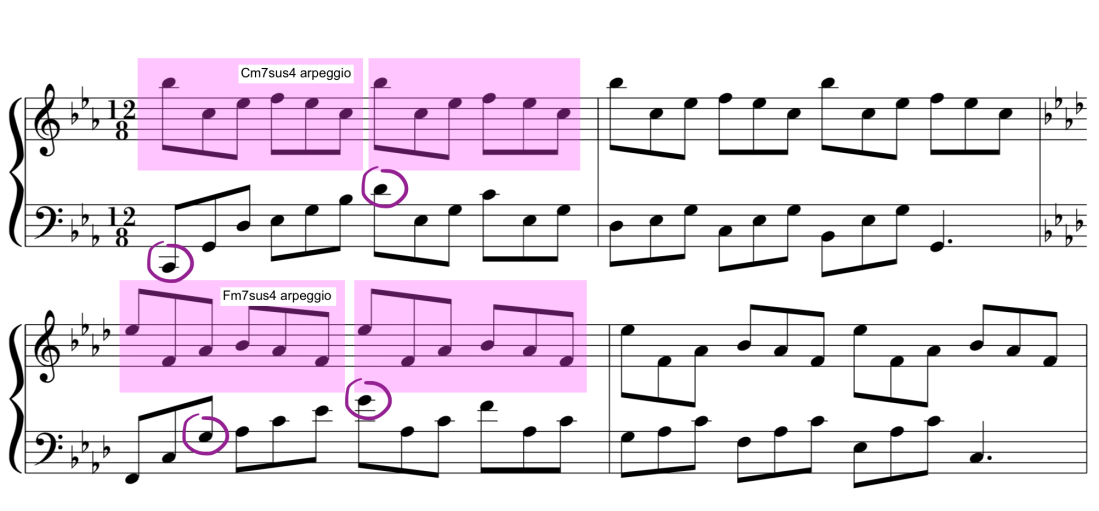What’s up people? Long time no see, huh? I’m sorry — I’ve been quite busy during the last two weeks working on a couple of scores (this one and this one) and preparing my new EP release. That includes some annoying promo job, but also cutting cool videos and animating photos shot by this extremely talented person. Anyway, let’s go back to the topic of this blog!
If you’re reading it for a while, you probably know my obsession with 10ths — the bigger thrids, the thirds that got out of puberty, or — as I used to call them when I was more involved in skateboarding — the ollie of left-hand patterns— I mean, you get it. The broken 10th chords sound freaking awesome, and when you master them, they take your playing to the next level and literally open new universes. In this sense, they are the ollie of piano 🛹 But like every cool trick, they get boring and dry if you don’t incorporate them into new, increasingly complex contexts. Luckily, there are endless possibilities for us to explore 🤓
Let’s talk about Erroll Garner’s ballad bass. Erroll Garner was an American jazz pianist who specialised in mid-tempo swing ballads with lush left-hand arrangements and insanely beautiful ornamental passages (that he played without even taking a single look at the keyboard, obviously). I was reading one of my favourite jazz books the other day, Jazz Piano: The Left Hand by Riccardo Scivales, and found a little extract from Garner’s composition that demonstrated his peculiar left-hand device. It was, of course, an immense waterfall of 32nd notes that I couldn’t play, so, as always, I did my little research and adapted the virtuoso line a bit to fit my needs.

What’s going on here? As you can see, it’s pretty much the broken 10th chord of Cm, but instead of 10th (that would be Eb) I’m first playing the minor 9th (which is D) and then proceed to the 10th. And then, to make it sound complete, I go ahead and play the major triad based on that 10th, which is the Eb major triad. And because it’s just not cool enough, I continue to play the 9th of Cm one octave above — which happens to be the major 7th of the Eb in the octave I’m currently in — which is, of course, the same D I played at the very beginning before the 10th. I’m pretty sure it sounds a bit entangled, but the idea is actually very simple: you take the minor chord, and you add a major III∆ chord on top of it, tying them together with a minor 9th. Man, that sounds beautiful!
And this is just the beginning! I’m going to keep developing this line and add some descending motion to it. Here is the pimped up version in Cm & Fm:

Same idea — starting on 1-5-9, then a III∆ chord built on the minor 10th, colour tone (pick your favourite — I used both octave or 9th here), and then a gradual descent back to where you started. I’m using the old trick here by revoicing my Eb chord as a 7-1-3 shell (playing 7th below the root), and my Cm chord as a 7-3-5 shell. One can, of course, think about these combinations of notes as completely different chords or even as individual scale degrees, but really, what I’ve noticed is that thinking in shell voicings could be an extremely powerful tool that helps you not to lose your position on the keyboard. Try it out!
Here’s the same approach used for two major chords (C & F):

Identical to minor, only this time I’m using major 9th, major 10th and my triad that I’m putting on top of the root chord is minor (e. g. C — Em, F — Am). Because you’re harmonising the major scale now mate! 😄 Plus, I chose to play just the root note of the V chord (as opposed to the whole triad in the previous example).
Talking about mixing major and minor — personally, I find these little injections of the opposite color (Eb∆ in Cm and Em in C) immensely beautiful and very satisfying. Playing such a line en lieu of a typical double octave or 1-5 bass creates ambiguity that might embellish otherwise dry and straightforward progression.
Here’s the excerpt that involves the right hand (playing sus4 arpeggio-based figures) in the keys of Cm and Fm:

I can play this one for hours (also working on my finger independence, actually! 😄) and still not get enough of this. So, definitely, thank you for inspiration, dear Mr. Garner 🙏🏻
As a closing part, I would like to share a little piece that is composed mostly using the above technique. Sheet music is available for download below.

That’s it for today, I hope I’ll be able to keep pauses between posts a bit shorter and get back to you very soon with some new practice ideas and studies! Let’s talk independence and modal mixture next time shall we? 🤓 Harmonise till it hurts—
